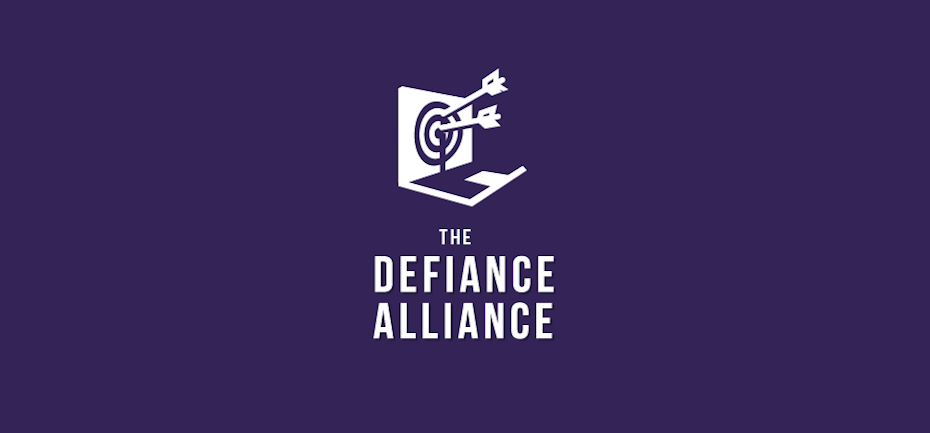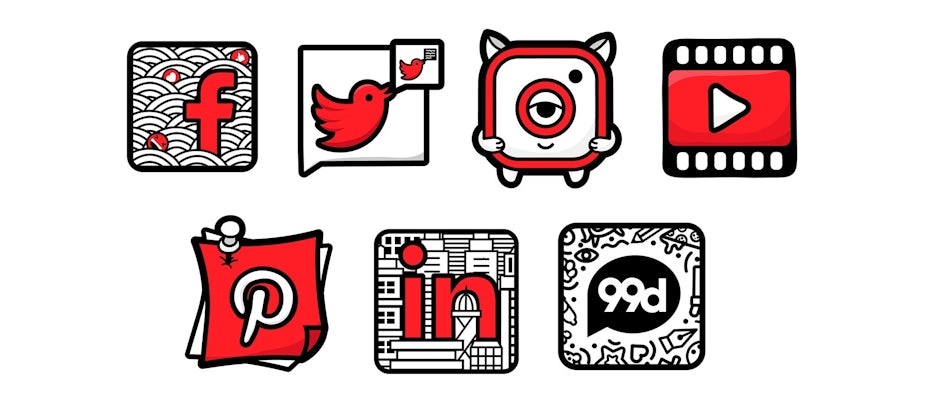“Strategy” may sound formal and calculating (and a strange companion for “social”) but a social media strategy is really all about making decisions ahead of time so that the time, money, and labor you put into your content will pay off. Your social strategy provides the framework for a decent first impression. Imagine your brand is about to go to a party. Your strategy would be which outfit you choose and why, what bottle of wine you decide to bring, how you approach small talk, and which hair metal 80s song you memorize to later slay at karaoke.
To make sure your brand is the life of the party, we’ve put together this guide to a winning social media strategy. We’ll cover how to develop goals, how to research your audience and competitors, and how to plan great content for social media.
1. Develop a social media mission statement
It all begins with the question: why do we need to be on social media?
These days, there’s no reason not to be on social media if you’re a business. But that does not mean you should start social media accounts for the sake of starting social media accounts. To be successful, you have to be able to first articulate how exactly you expect social media to contribute to your success.
Put another way, ask yourself: what problem are we trying to solve? Do new promotions and campaigns not seem to reach enough people? Do sales numbers need a boost? Is your brand personality not as clear as it could be?

Starting with questions like these allows you to set big picture goals. This can also come in the form of a mission statement, a concise description outlining your objectives and how you will use social media to achieve them. As your strategy evolves, your goals will become finely tuned and specific. But a high level mission statement like this gives you a big target towards which steer all the moving parts of a social media campaign. Now, let’s look at how to construct goal statements like this in more detail.
2. Set SMART social media goals
A time-honored framework for articulating goals is the S.M.A.R.T. system. It involves setting goals that are…
- Specific. The goal has a specified process, audience, and expected outcomes.
- Measurable. The goal includes numerical means to track and compare progress.
- Attainable. The goal is reasonably within your business’s capabilities.
- Relevant. The goal advances an aspect of your overall business strategy.
- Time-bound. The goal has a start and end point.
This means that instead of, “We want to use social media to get more followers who will buy more of our products!” you say something closer to: “We are going to develop X number of content pieces on these topics to target these customers (specific) over X number of months (time-bound) to increase our sales for X product X% (measurable, attainable) over last quarter (relevant).

While the particular goals that you set for social media will depend on your brand and business strategy, here are some common uses social media can serve:
- Sales conversion: Strategy focused on improving sales.
- Audience growth: Strategy focused on creating new followers.
- Brand awareness: Strategy focused on establishing or spreading information about a brand.
- Brand perception: Strategy focused on positively influencing the conversations people have about a brand.
- Customer engagement: Strategy focused on creating dialogue and brand advocation amongst customers.
- Customer support: Strategy focused on providing assistance and answering customer questions.
3. Define your target audience
By now, you should already have researched your target (and actual) audience for your overall business. If not, here’s some tips on defining your audience.
While your social media followers will factor into your larger audience, you should not assume they are the same (or even the same for every social platform). They may represent a cross-section, a more niche selection, or even an unexpectedly different audience altogether. In order to create the kind of content that will meet your goals, you’ll need to research who exactly this content is for.

Each social media platform has its own user-base and trends, and most of these have been heavily documented over the years. For example, sites like Statista provide comprehensive, up-to-date statistics on topics like social media marketing. Though not as thorough, industry content providers like Hubspot, Hootsuite, and Sprout Social also round up demographic statistics for free.
If you already have social media accounts, you should also research who is currently following you. Each platform will have its own analytics tools that can pull information about your followers from their profile data (google the platform with the term “for business”). Otherwise, tools like Hootsuite can cross-reference follower data from all of your linked social accounts.

As with any social scenario, there can be a lot of stereotypes about the types of people who participate on certain platforms (one of the most common: that newer apps are automatically only for tweens). As a business, it is your responsibility to base your strategy on real data.
Once you have collected all of your findings on your audience (both current and potential) into one document, you can make decisions about what portion of them you want to target based on what will help you achieve your goals. Some questions to ask are:
- What common demographic information do we know about our customers?
- What platforms do they commonly use and how?
- What are they looking for on social media that we can deliver to them?
As your final step, it is important to create personas that represent different sections of your target audience. Demographic information can help you to understand your audience’s income, location, habits and values, but it tends to be a cold and clinical way of thinking about people. Social media is about creating conversations, and it can be hard to do so with statistical data. Personas help you to visualize the actual people you are looking to connect with, and to brainstorm how your content will meet them along their buyer’s journey.
4. Choose the best social media platforms for your brand
There are dozens of popular social media apps that your brand could take advantage of. Because it can take a lot of time and money to get the most out of any platform, you need to dedicate your business resources to the platforms that will give you the most return on investment, or ROI.

Start with your existing accounts if you have them. Assuming that you now have a better sense of your goals and target audience, you can honestly evaluate whether these specific platforms are right for what you’re trying to accomplish and, if so, how effectively you’ve been capitalizing on them. This is known as a social media audit, in which you create a document to analyze your past content performance, giving you a place to start for future growth. To perform an audit:
- Document all of your accounts (note relevancy, when it was last updated, brand consistency and the profile page setup)
- Evaluate your audience and following (as outlined in the previous section)
- Analyze the performance of your content (as compared against your goals)
Beyond existing channels, research potential new channels to add. Your options will be based on the audiences those platforms cater to as well as the types of content that performs well. Each channel is typically made for specific content (Instagram is generally for image based media, YouTube is for videos, etc) which any time spent on that platform observing user generated content will tell.
Lists like these also collect common social media trends and user behavior that can play into your goals. For example, Instagram is the most popular platform for collaborating with influencers, and paid ads tend to perform better on Facebook. Though there are usually ways to include atypical content on any platform, playing to the platform’s strengths will make your life easier.


With all that said, the most popular social media platforms by far are Facebook, Twitter, Instagram, and LinkedIn. Although you don’t have to invest heavily in these platforms if they don’t suit your goals, having an account set up on all of them is recommended. Not only are they the most common places people will look to interact with your brand, they often rank high in search engine results.
5. Research your competitors and other user generated content
The great thing about a social media strategy is that you never really start from nothing. Each platform is full of brands whose strategy is on display for you to admire and learn from—provided you know what to look for.

The most important user content to analyze is that of your competitors. Although you don’t have access to their analytics, likes and shares can reveal reach and visibility, and comments can show how effective their content is at sparking conversations. Similar to your own social media audit, you’ll want to document your competitor’s social media activity across different channels, paying attention to the kinds of content they are producing, how that content is received, and how they interact with their followers (for insight on metrics to track, jump to step 7).
Tools like Hootsuite and its integration Brandwatch can allow you to search for your competitors by name and monitor what people are saying about them on social media, who their top followers are, who is advocating for them, which can help you determine the effectiveness of their content. There are also a lot of free resources for industry analysis, including Buffer’s annual State of Social, which can show you the percentage of brands that adopt particular strategies.
Beyond your competitors, it is also important to make a list or moodboard of general social media accounts that you like. What campaigns speak to you and your team on an individual level may not always align with one another or even fit within the context of your brand. But this offbeat inspiration can end up being the secret ingredient that turns your content into something special. A great source for this are industry awards, such as the Webbys and Shorty Awards, which round up excellent social media campaigns and content examples yearly.
6. Create a content pipeline for each social media channel
Knowing your goals, target audience, platforms, and competitors is all well and good. But the day-to-day content you post is where your social media efforts will succeed or fail. The good news is that your strategy can account for a sustainable plan to create and deliver content.
Keyword research can give you insight into the topics people are interested in. This means using a tool like Google Trends to see what search terms users are commonly using when researching a subject. You can cross reference this with the platform’s analytic tools to highlight specific trending topics on social media. Doing so can show you what questions users have, and you can brainstorm ways to meet those needs with your content.

Next, you should create a content calendar, essentially a schedule for developing and publishing content. A good content calendar will account for every step in the process, whether you’re producing blog articles or tweets. You should set deadlines for briefing, copy expectations, graphic design assets and editing. We use CoSchedule for our content, but there are many good content and social media scheduling tools out there and if you’re in a pinch, even a spreadsheet can work. What matters is that you are able to evenly distribute your workload and monitor deadlines.
When it comes to creating content, it is not uncommon for businesses to supplement their in-house talent with freelancers. Writer platforms like Contently can be a source for finding freelance copy and blog writers. Having great visuals is crucial for social media, so working with a graphic designer can take your social channels to the next level. For all your design needs, 99designs offers a global network of creatives for hire. You can browse designer profiles, narrow your search by style, price point, and availability, and find the perfect freelance designer for your needs. You can conduct feedback and secure payments all in the project workspace.
Because your strategy will evolve over time, a great benefit of sites like these is that they give you access to a varied range of freelancers to help support your changing needs.
>> Check out our complete guide to social media design

7. Adjust your social media strategy as you go
Social media posts tend to have a lifespan of a few days at best. The speed with which your social media posts generate results lets you to quickly identify what works and what doesn’t and adjust your strategy accordingly.
A high number of likes is never a bad thing (especially when it comes to boosting your post’s ranking), but remember that it doesn’t take much effort for users to like or even share a post. Many do so while passively scrolling, often forgetting the post within the next few seconds as new content takes its place. In addition to likes, there’s a wide variety of metrics that you can review to monitor how you’re performing (social media platforms and management tools can help with that). Here are some of the most helpful:
- Impressions. This is the amount of people that see your content. While not the most helpful on its own, you can compare it against many of the below metrics.
- Approval. The number of likes a post gets compared to your total follower count, showing you what portion of your audience is paying attention to and approves of your content.
- Mentions. This is who mentions your brand by name, whether directly (with an @ or comments) or indirectly. Indirect mentions are a useful way of seeing how people are talking about your brand naturally to their friends.
- Shares. This is the amount of people who share your content with their friends, adding to its viral potential. It involves reviewing not only the specific number of shares but the size of the audience of each sharer.
- Follower growth. This is the rate at which you gain new followers, and it can show you how effective your content is at expanding your audience.
- Conversion rate. This shows the rate at which a social media post leads to a purchase, often using a URL shortener to track clicks. It is helpful to compare this to the number of impressions or views.
- Click-Through-Rate. This is the rate at which people click through to see additional content, such as a blog article.
These metrics can help you understand what works, what your audience likes to see from you and whether your social media strategy is moving in the right direction.

Analytics are not the only changes you will have to keep your eye on. As much as your strategy might try, you can never predict what trending topics people are interested in talking about. Relevancy is important for keeping up with the conversation on social media, but you should also be wary in your approach to trends. Your brand can easily come off as tone deaf if you’re riding the coattails of popular memes or thoughtlessly capitalizing on pressing social issues. Pick your battles carefully—not every conversational trend needs your input.
Remaining genuine is key here: your brand personality will guide whether or not you have something substantive to offer a trending topic.
Make social media strategy a habit
—
Although it is impossible to predict where any conversation will go on social media, a strategy is what prepares you to present your best self. And of course, making a strategy is not a one-time event. If your strategy does not at first yield you the results you want, there’s nothing stopping you from periodically revisiting and revising it.
While strategy is helpful for success, attractive content is where your brand will sink or swim in the waters of social media. If you want the kind of posts that make followers pay attention, a professional designer is a must-have.
Boost your social game with the finest social media design
Our social media designers can help you get your message out.
The post How to develop a successful social media strategy in 7 simple steps appeared first on 99designs.
No comments:
Post a Comment